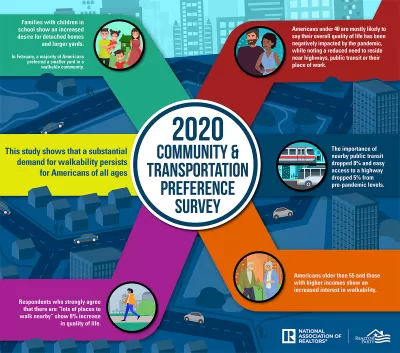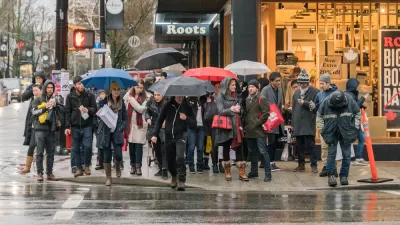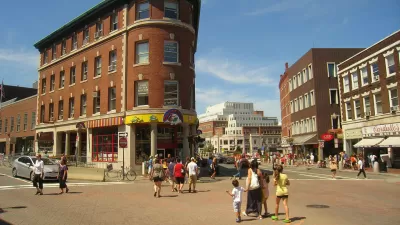The National Association of Realtors' recent Community and Transportation Preference Survey shows that many households prefer living in walkable urban neighborhoods, and those that do have a higher quality of life.

The National Association of Realtors' (NAR) 2020 Community and Transportation Preference Survey investigates how COVID has affected housing and travel preferences. It finds that many households would prefer to live in more walkable neighborhoods, and residents of such areas report a higher quality of life than those who live in less walkable areas.
NAR’s biannual Community & Transportation Preferences Surveys poll residents in America’s 50 largest metropolitan areas. The first 2020 survey was conducted in February, immediately before the impacts of COVID-19 began to be felt, and again at the end of July.
The survey found that Americans under 40 (millennials and Generation Y) are most likely to say their overall quality of life has been negatively impacted by the pandemic, while they also note a reduced need to reside near highways, public transit or their place of work. Although COVID has dramatically changed people’s lives, this study shows that a substantial demand for walkability persists for Americans of all ages,” Malta added.
Among other noteworthy findings of the July survey:
- Respondents who strongly agree that there are “lots of places to walk nearby” show an 8% increase in quality of life.
- Americans older than 55 and those with higher incomes show an increased interest in walkability.
- Families with children in school show an increased desire for detached homes and larger yards.
- The importance of easy access to public transit and highways dropped 8% and 5%, respectively, from pre-pandemic levels.
FULL STORY: Community and Transportation Preference Surveys

Maui's Vacation Rental Debate Turns Ugly
Verbal attacks, misinformation campaigns and fistfights plague a high-stakes debate to convert thousands of vacation rentals into long-term housing.

Planetizen Federal Action Tracker
A weekly monitor of how Trump’s orders and actions are impacting planners and planning in America.

Chicago’s Ghost Rails
Just beneath the surface of the modern city lie the remnants of its expansive early 20th-century streetcar system.

Bend, Oregon Zoning Reforms Prioritize Small-Scale Housing
The city altered its zoning code to allow multi-family housing and eliminated parking mandates citywide.

Amtrak Cutting Jobs, Funding to High-Speed Rail
The agency plans to cut 10 percent of its workforce and has confirmed it will not fund new high-speed rail projects.

LA Denies Basic Services to Unhoused Residents
The city has repeatedly failed to respond to requests for trash pickup at encampment sites, and eliminated a program that provided mobile showers and toilets.
Urban Design for Planners 1: Software Tools
This six-course series explores essential urban design concepts using open source software and equips planners with the tools they need to participate fully in the urban design process.
Planning for Universal Design
Learn the tools for implementing Universal Design in planning regulations.
planning NEXT
Appalachian Highlands Housing Partners
Mpact (founded as Rail~Volution)
City of Camden Redevelopment Agency
City of Astoria
City of Portland
City of Laramie





























